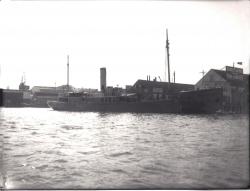Created by Lyman Moore Middle School students
Union Wharf is one of the oldest structures in Portland, Maine. Throughout its history it has been through a fire that almost destroyed the whole city, a sea battle that killed two captains, and the threat of German U-boats.
Union Wharf is still a monument to the people who built it. They used horse wagons to move rocks, dirt and other materials to make the wharf. They used more than 3,500 tons of lumber for the wharf, which would soon extend far into the bay.
At the beginning of Union Street a breastwork was built. A breastwork is a dock that is made of stones and rubble where ships loaded and unloaded their materials.
The Portland Harbor was a busy place in the late 1700s. For example, in 1793 twenty-three schooners, twenty sloops, and thirteen ships docked in the port that year.
In 1793 Union Wharf was built at the bottom of Portland's Union Street, for which the wharf is named. A group of twenty-five men agreed to build the wharf. It was stated on the deed of the wharf, the wharf was built to bring stores and bussinesses to the waterfront.
"Proprietors of Union Wharf" is what the constructors of Union Wharf named themselves. In 1792 the group had voted that they were to sell their shares at about 50 pounds each. They did this to raise money to build the wharf. Enoch Ilsley, David Smith, Robert Boyd and Joseph Jewett each bought two shares. One proprietor, Nathaniel Deering had no share.
In 1797 writer Timothy Dwight wrote that "no American town was more commercial or sprighty than Portland." Business grew in Portland as did Union Wharf as the nation went into the nineteenth century. Portland became America's sixth largest seaport in 1806.
At various times, trade at Union Wharf and along Portland's waterfront has been threatened.
After the Revolutionary War England and the United States? relationship deteriorated. At that time, Portland was a town of about three thousand people. Workers with marine related jobs, as well as many sailors, were now jobless.
The United States government enforced a law that did not allow trade with England. Many upset citizens disliked this law and continued to trade with England anyway.
In the 19th century Portland started to grow and progress. Portland was getting so big that some of back bay and the harbor itself had to be filled in. This killed some industries on the wharves. Larger ships could not come up to the wharves anymore because the harbor was smaller. However, the landfill allowed for new buissnesses, places for people to live and eventually the tourists we see today.
The Grand Trunk Railroad was built when the back bay and harbor were filled in. The Grand Trunk Railroad was built so that products could be shiped from the waterfront and Union Wharf to Montreal.
The railroads also opened other ways to go to Boston and let people come to Portland. The railroad delivered goods to the wharves and helped passengers to come in and out of Portland.
Mending nets and drying cod fish were a major part of work. People got more jobs and Union Wharf was more successful. Flake yards were always booming with fishing and mending nets. Union Wharf was a great place to buy fish and nets. Also, Union Wharf was a major place to buy lobster nets, traps and bait. Decades later these items can still be purchased on this very active wharf.
Another wharf to be built on Portlands waterfront was Custom House Wharf. Union Wharf was the longest wharf until people started to build more wharves. These wharfs were built to keep the fishing and shipping industries alive. More wharves created more jobs. Boats could now enter the harbor and have a variety of wharves to park at. Custom House Wharf kept lobstering alive and increased jobs.
Hoist wheels were used to hoist heavy objects up on the dock by shifting the weight from the front to the back of the wheel with a rope. It took one to two men to use a hoist wheel. Hoist wheels were a very big help for men on the docks to lift heavy objects. Now they use fork lifts and cranes to lift the objects from boats to the docks and it only takes one person to do this.
We would like to thank Angela Clark for giving us a tour of Union Wharf and for letting us interview her.
We would also like to thank Steve Bromage and Phoebe Tureen for helping us with our project. Also, we would like to thank Ray St. Pierre, our teacher, for helping us.
Thank You all for helping us with our project!
Bibliography
Gold, Susan and Jill Cournoyer. The History Of Union Wharf, Saco, Maine: Custom Communications, 1998.
Clark, Angela. Union Wharf walking tour/Interview Portland, Maine.











